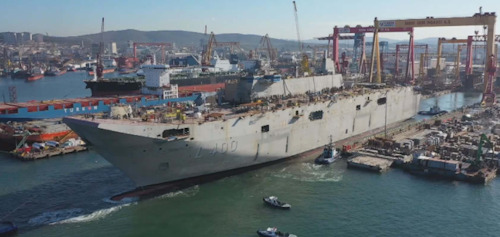Given the success the Turkish TB2 armed drones are having Bayraktar, in the various operational theaters in which Ankara decides to use them, the Kazakh government has decided to buy them instead of the Chinese ones.
The recent use in the Nagorno-Karabakh conflict has highlighted its effectiveness and, more generally, has highlighted the potential of UAVs (Remotely Piloted Aircraft) armed in a conventional conflict.
Turkey has used the TB2 UCAVs (in addition to the Anka drones - following photo), produced by Turkish Aerospace Industries (TAI), in operations in Syria and Libya. In the latter theater they played a decisive role in lifting the siege of Tripoli by the forces of General Haftar.
Today, more and more states are deciding to acquire armed APRs, especially in the MALE (Medium Altitude Long Endurance) category, but the demand for lower category drones, such as tactical UAVs, is also growing. The latter were widely used in Syria by the Russian contingent for the control and coordination of artillery fire.

Initially, the drones' task was to slowly circle, for an acceptable number of hours, monitoring a certain area and identifying the target that other assets would then hit. Subsequently, from an ISR (Intelligence, Surveillance and Reconnaissance) platform, drones evolved into attack vectors.
The strategic scenarios we are witnessing increasingly delineate a return to the conventionality of war (however asymmetric conflicts remain), perhaps declined in a conflict hybrid, where irregular groups, with the support of a state actor, have sophisticated weapons capable of putting even the most advanced armed forces in difficulty.
In this context, the need to design alternative drones to the classic reconnaissance UAV stands out. In fact, in future war scenarios, it will be required to operate in highly protected contexts (bubbles A2 / AD) and where the drones will have to penetrate the opposing defensive device, looking for a target paying (as C4I centers).
 Nations like Turkey are investing heavily in the development of increasingly sophisticated UCAVs (with increasingly stealthy and streamlined aerodynamic formulas).
Nations like Turkey are investing heavily in the development of increasingly sophisticated UCAVs (with increasingly stealthy and streamlined aerodynamic formulas).
Furthermore, given the failure to acquire the F-35B, Ankara is planning an armed drone that can be loaded on the new aircraft carrier. Anadolu (photo) which will be operational in 2021.
A path that the Navy should also follow, given the low number of F-35Bs purchased (15 cars) and the considerable delay - according to the chief of staff Cavo Dragone - accumulated in the process of integrating the new aircraft with the Cavour.
Photo: Presidency of the Republic of Turkey / Türk Silahlı Kuvvetleri / DHA












